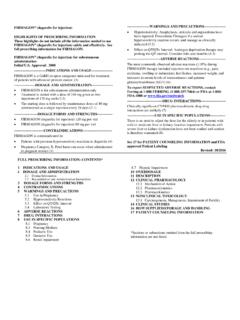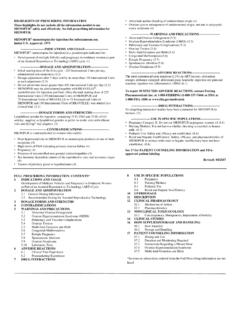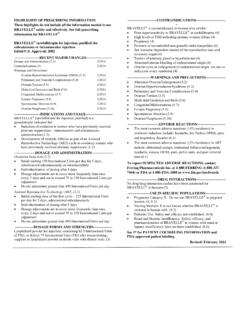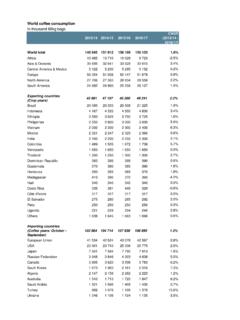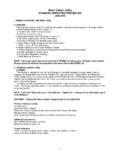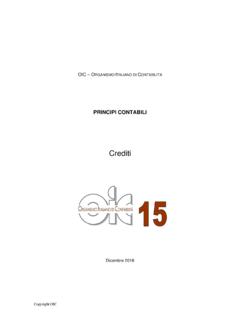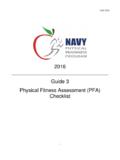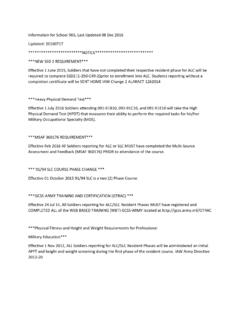Transcription of CERVIDIL® - FerringUSA
1 CERVIDIL Brand of dinoprostone vaginal insert Rev. 02/ 2016 Rx only 6870-03 DESCRIPTION Dinoprostone vaginal insert is a thin, flat, polymeric slab which is rectangular in shape with rounded corners contained within the pouch of an off-white knitted polyester retrieval system. Each slab is buff colored, semitransparent and contains 10 mg of dinoprostone in a hydrogel insert. An integral part of the knitted polyester retrieval system is a long tape designed to aid retrieval at the end of the dosing interval or earlier if clinically indicated. The finished product is a controlled release formulation which has been found to release dinoprostone in vivo at a rate of approximately mg/hr. The chemical name for dinoprostone (commonly known as prostaglandin E2 or PGE2) is 11 ,15S-dihydroxy-9- oxo-prosta-5Z,13E-dien-1- oic acid and the structural formula is represented below: The molecular formula is C20H32O5 and its molecular weight is Dinoprostone occurs as a white to off-white crystalline powder.
2 It has a melting point within the range of 65o to 69oC. Dinoprostone is soluble in ethanol and in 25% ethanol in water. Each insert contains 10 mg of dinoprostone in 241 mg of a cross-linked polyethylene oxide/urethane polymer which is a semi-opaque, beige colored, flat rectangular slab measuring 29 mm by mm and mm in thickness. The insert and its retrieval system, made of polyester yarn, are non-toxic and when placed in a moist environment, absorb water, swell, and release dinoprostone. CLINICAL PHARMACOLOGY Dinoprostone (PGE2) is a naturally-occurring biomolecule. It is found in low concentrations in most tissues of the body and functions as a local hormone (1-3). As with any local hormone, it is very rapidly metabolized in the tissues of synthesis (the half-life estimated to be minutes). The rate limiting step for inactivation is regulated by the enzyme 15-hydroxyprostaglandin dehydrogenase (PGDH) (1,4). Any PGE2 that escapes local inactivation is rapidly cleared to the extent of 95% on the first pass through the pulmonary circulation (1,2).
3 In pregnancy, PGE2 is secreted continuously by the fetal membranes and placenta and plays an important role in the final events leading to the initiation of labor (1,2). It is known that PGE2 stimulates the production of PGF2 which in turn sensitizes the myometrium to endogenous or exogenously administered oxytocin. Although PGE2 is capable of initiating uterine contractions and may interact with oxytocin to increase uterine contractility, the available evidence indicates that, in the concentrations found during the early part of labor, PGE2 plays an important role in cervical ripening without affecting uterine contractions (5-7). This distinction serves as the basis for considering cervical ripening and induction of labor, usually by the use of oxytocin (8-10), as two separate processes. PGE2 plays an important role in the complex set of biochemical and structural alterations involved in cervical ripening. Cervical ripening involves a marked relaxation of the cervical smooth muscle fibers of the uterine cervix which must be transformed from a rigid structure to a softened, yielding and dilated configuration to allow passage of the fetus through the birth canal (11-13).
4 This process involves activation of the enzyme collagenase, which is responsible for digestion of some of the structural collagen network of the cervix (1,14). This is associated with a concomitant increase in the amount of hydrophilic glycosaminoglycan, hyaluronic acid and a decrease in dermatan sulfate (1). Failure of the cervix to undergo these natural physiologic changes, usually assessed by the method described by Bishop (15,16), prior to the onset of effective uterine contractions, results in an unfavorable outcome for successful vaginal delivery and may result in fetal compromise. It is estimated that in approximately 5% of pregnancies the cervix does not ripen normally (17). In an additional 10-11% of pregnancies, labor must be induced for medical or obstetric reasons prior to the time of cervical ripening (17). The delivery rate of PGE2 in vivo is about mg/hour over a period of 12 hours. The controlled release of PGE2 from the hydrogel insert is an attempt to provide sufficient quantities of PGE2 to the local receptors to satisfy hormonal requirements.
5 In the majority of patients, these local effects are manifested by changes in the consistency, dilatation and effacement of the cervix as measured by the Bishop score. Although some patients experience uterine hyperstimulation as a result of direct PGE2- or PGF2 -, mediated sensitization of the myometrium to oxytocin, systemic effects of PGE2 are rarely encountered. The insert is fitted with a biocompatible retrieval system which facilitates removal at the conclusion of therapy or in the event of an adverse reaction. No correlation could be established between PGE2 release and plasma concentrations of PGEm. The relative contributions of endogenously and exogenously released PGE2 to the plasma levels of the metabolite PGEm could not be determined. Moreover, it is uncertain as to whether the measured concentrations of PGEm reflect the natural progression of PGEm concentrations in blood as birth approaches or to what extent the measured concentrations following PGE2 administration represent an increase over basal levels that might be measured in control patients.
6 INDICATIONS AND USAGE Cervidil Vaginal Insert (dinoprostone, 10 mg) is indicated for the initiation and/or continuation of cervical ripening in patients at or near term in whom there is a medical or obstetrical indication for the induction of labor. CONTRAINDICATIONS Cervidil is contraindicated in: Patients with known hypersensitivity to prostaglandins. Patients in whom there is clinical suspicion or definite evidence of fetal distress where delivery is not imminent. Patients with unexplained vaginal bleeding during this pregnancy. Patients in whom there is evidence or strong suspicion of marked cephalopelvic disproportion. Patients in whom oxytocic drugs are contraindicated or when prolonged contraction of the uterus may be detrimental to fetal safety or uterine integrity, such as previous cesarean section or major uterine surgery (see PRECAUTIONS and ADVERSE REACTIONS). Patients already receiving intravenous oxytocic drugs. Multipara with 6 or more previous term pregnancies.
7 WARNINGS For hospital use only Cervidil should be administered only by trained obstetrical personnel in a hospital setting with appropriate obstetrical care facilities. Women aged 30 years or older, those with complications during pregnancy and those with a gestational age over 40 weeks have been shown to have an increased risk of postpartum disseminated intravascular coagulation. In addition, these factors may further increase the risk associated with labor induction (See ADVERSE REACTIONS, Post-marketing surveillance). Therefore, in these women, use of dinoprostone should be undertaken with caution. Measures should be applied to detect as soon as possible an evolving fibrinolysis in the immediate post-partum period. The Clinician should be alert that use of dinoprostone may result in inadvertent disruption and subsequent embolization of antigenic tissue causing in rare circumstances the development of Anaphylactoid Syndrome of Pregnancy (Amniotic Fluid Embolism).
8 PRECAUTIONS 1. General Precautions: Since prostaglandins potentiate the effect of oxytocin, Cervidil must be removed before oxytocin administration is initiated and the patient s uterine activity carefully monitored for uterine hyperstimulation. If uterine hyperstimulation is encountered or if labor commences, the vaginal insert should be removed. Cervidil should also be removed prior to amniotomy. Cervidil is contraindicated when prolonged contraction of the uterus may be detrimental to fetal safety and uterine integrity. Therefore, Cervidil should not be administered to patients with a history of previous cesarean section or uterine surgery given the potential risk for uterine rupture and associated obstetrical complications, including the need for hysterectomy and the occurrence of fetal or neonatal death. Caution should be exercised in the administration of Cervidil for cervical ripening in patients with ruptured membranes, in cases of non-vertex or non-singleton presentation, and in patients with a history of previous uterine hypertony, glaucoma, or a history of childhood asthma, even though there have been no asthma attacks in adulthood.
9 Uterine activity, fetal status and the progression of cervical dilatation and effacement should be carefully monitored whenever the dinoprostone vaginal insert is in place. With any evidence of uterine hyperstimulation, sustained uterine contractions, fetal distress, or other fetal or maternal adverse reactions, the vaginal insert should be removed. An increased risk of post-partum disseminated intravascular coagulation has been described in patients whose labor was induced by physiologic means, either with dinoprostone or oxytocin. 2. Drug Interactions: Cervidil may augment the activity of oxytocic agents and their concomitant use is not recommended. A dosing interval of at least 30 minutes is recommended for the sequential use of oxytocin following the removal of the dinoprostone vaginal insert. No other drug interactions have been identified. 3. Carcinogenesis, Mutagenesis, Impairment of Fertility: Long-term carcinogenicity and fertility studies have not been conducted with Cervidil (dinoprostone) Vaginal Insert.
10 No evidence of mutagenicity has been observed with prostaglandin E2 in the Unscheduled DNA Synthesis Assay, the Micronucleus Test, or Ames Assay. 4. Pregnancy, Teratogenic Effects: Prostaglandin E2 has produced an increase in skeletal anomalies in rats and rabbits. No effect would be expected clinically, when used as indicated, since Cervidil (dinoprostone) Vaginal Insert is administered after the period of organogenesis. Prostaglandin E2 has been shown to be embryotoxic in rats and rabbits, and any dose that produces sustained increased uterine tone could put the embryo or fetus at risk. 5. Pediatric Use: The safety and efficacy of Cervidil has been established in women of a reproductive age and women who are pregnant. Although safety and efficacy has not been established in pediatric patients, safety and efficacy are expected to be the same for adolescents. ADVERSE REACTIONS Cervidil is well tolerated. In placebo-controlled trials in which 658 women were entered and 320 received active therapy (218 without retrieval system, 102 with retrieval system), the following events were reported.


